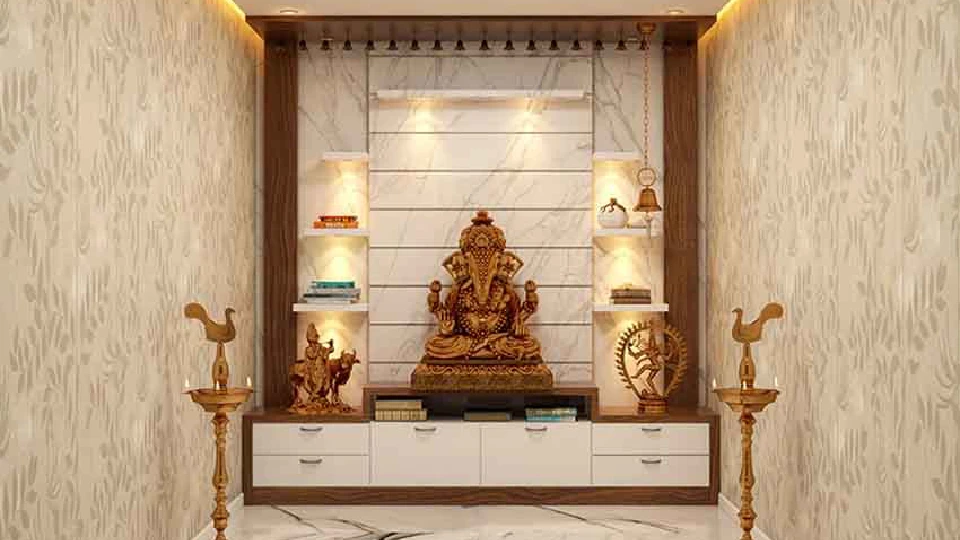A mandir for home is not just a place of worship; it is the spiritual heart of your house where you connect with divine energy. According to Vastu Shastra, the placement and direction of the pooja room and the direction the idols or images of God face are crucial to ensure positivity, harmony, and prosperity in your home.
In this blog, we’ll explore the ideal placement for a pooja room and the god face direction in a pooja room, along with practical Vastu tips for your home mandir.
Why Vastu Shastra is Important for Pooja Room Placement
Vastu Shastra is an ancient Indian architectural science that focuses on aligning energies within a space. A properly placed pooja room enhances the flow of positive energy, bringing peace, prosperity, and spiritual growth to the household.

Ideal Direction for the Pooja Room
1. Best Direction: Northeast (Ishan Kon)
The northeast corner of the house is considered the most auspicious location for the pooja room. This direction is associated with divine energies and is believed to be ideal for spiritual practices.
2. Alternative Directions
If the northeast is unavailable, you can consider the east or north directions for your pooja room. These directions align well with positive cosmic energies.
3. Directions to Avoid
- Southwest: Associated with stability but not suitable for a pooja room.
- Southeast: Ruled by fire, which may disrupt the peace of the space.
- Bathrooms or Bedrooms Nearby: Avoid placing the pooja room near bathrooms or inside bedrooms to maintain the sanctity of the space.
God Face Direction in Pooja Room
The direction in which the idols or images of God face in the mandir for home is equally important:
1. Idols Should Face the West or South
- Devotees should face east or north while praying, ensuring they are aligned with positive energies.
- Therefore, the idols or images of God should ideally face the west or south direction.
2. Idol Placement Tips
- Distance from Wall: Keep idols at least 1-2 inches away from the wall to allow free energy flow.
- Avoid Clutter: Do not overcrowd the pooja room with too many idols or decorations.
Key Vastu Tips for Pooja Room
1. Materials for Mandir
- Use wood or marble for the mandir to enhance its sacredness and durability.
- Avoid using plastic or glass for the structure, as these materials are not considered auspicious.
2. Pooja Room Door
- If possible, have a door for the pooja room to maintain privacy and sanctity. A wooden door with subtle designs is ideal.
3. Lighting and Décor
- Ensure the pooja room is well-lit with natural or artificial lighting. A diya or lamp should always be placed in the southeast corner of the room.
- Use light and calming colors like white, yellow, or cream for the pooja room walls.
4. Avoid Placing Pooja Room Under stairs
Placing the pooja room under a staircase is considered inauspicious as it is associated with negative energy.
5. Cleanliness and Purity
- Keep the pooja room clean and clutter-free at all times.
- Avoid storing non-religious items like unused items, clothes, or cleaning supplies in the pooja room.
Common Mistakes to Avoid in Pooja Room Placement
- Pooja Room in the Kitchen: This disrupts the sanctity of the space.
- Facing the South While Praying: This direction is considered inauspicious.
- Using Broken Idols or Photos: Always ensure that the idols or images are intact and not damaged.
- Placing the Pooja Room in the Basement: This location is considered too low for divine energy to flow effectively.

FAQs
1. What is the ideal height for the mandir in the pooja room?
The mandir should be placed at chest level or higher so that you can pray while standing or sitting without looking down at the idols.
2. Can the pooja room be in the living room?
Yes, if space is limited, you can place the pooja room in the living room. Ensure it is in the northeast corner and separated from the main area using a partition.
3. Is it okay to place a pooja room in a flat or small apartment?
Yes, even small spaces can accommodate a mandir for home. Use a compact wooden or marble mandir and follow the same Vastu guidelines for direction and placement.
Conclusion
Designing a mandir for home according to Vastu principles ensures that your pooja room becomes a sanctuary of peace and positivity. Placing the mandir in the northeast direction and ensuring the god face direction in the pooja room aligns with Vastu Shastra can amplify spiritual energy and bring prosperity to your household.
Implement these tips to create a divine space that radiates harmony and blessings in your home!







